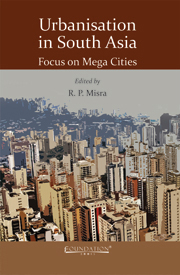Book contents
- Frontmatter
- Contents
- List of Figures
- List of Tables
- List of Contributors
- Introdution
- 1 South Asia: Land, People, and Economy
- 2 Historical Roots of South Asian Urbanisation
- 3 Mumbai: The Financial Capital of India
- 4 Delhi: Growing Problems of a Growing Megalopolis
- 5 Calcutta: The Emergence of Colonial Settlement into Megacity of the East
- 6 Chennai: A Rural Metropolis in Search of Modernity
- 7 Hyderabad: From the Feudal City to a Hi-Tech Metropolis
- 8 Bangalore: From Garden City to Silicon Valley of India
- 9 Karachi: The Commercial Capital of Pakistan
- 10 Lahore: The Cultural Heart of Pakistan
- 11 Kabul: A City in Perpetual Turmoil
- 12 Dhaka: A Mega City of Persistence and Change
- 13 Kathmandu: A City Where Tradition and Modernity Overwhelm Each Other
- 14 Thimphu: The City of Peace and Organic Development
- 15 Colombo: The Primate City of Sri Lanka
- 16 Male: Island Capital of an Island Nation
- 17 Beyond the Present: Vision of a New Urban Future
- Index
14 - Thimphu: The City of Peace and Organic Development
Published online by Cambridge University Press: 05 September 2013
- Frontmatter
- Contents
- List of Figures
- List of Tables
- List of Contributors
- Introdution
- 1 South Asia: Land, People, and Economy
- 2 Historical Roots of South Asian Urbanisation
- 3 Mumbai: The Financial Capital of India
- 4 Delhi: Growing Problems of a Growing Megalopolis
- 5 Calcutta: The Emergence of Colonial Settlement into Megacity of the East
- 6 Chennai: A Rural Metropolis in Search of Modernity
- 7 Hyderabad: From the Feudal City to a Hi-Tech Metropolis
- 8 Bangalore: From Garden City to Silicon Valley of India
- 9 Karachi: The Commercial Capital of Pakistan
- 10 Lahore: The Cultural Heart of Pakistan
- 11 Kabul: A City in Perpetual Turmoil
- 12 Dhaka: A Mega City of Persistence and Change
- 13 Kathmandu: A City Where Tradition and Modernity Overwhelm Each Other
- 14 Thimphu: The City of Peace and Organic Development
- 15 Colombo: The Primate City of Sri Lanka
- 16 Male: Island Capital of an Island Nation
- 17 Beyond the Present: Vision of a New Urban Future
- Index
Summary
Bhutan, a relatively small kingdom in the lap of the Eastern Himalayas is unique in many ways. It is a democratic kingdom where the king took the initiative to transfer his powers to the people. It is trying to enter the new millennium without compromising with its cultural values, age old traditions, and natural beauty. The development path it has selected does not pass through urbanisation and industrialisation; it passes through a judicious mix of rural and urban setting where human values reign supreme. And last but not the least it has given to the world a new measure of development known as gross domestic happiness (GDH). The kingdom stands first in GDH in South Asia and eighth in the World.
Bhutan is a country of highly dispersed village settlements isolated from each other or linked with mountain trails. People reside in the valleys and mountain slopes and eke out their living from subsistence farming. In a country of less than 700,000 inhabitants, the scope for the development of major cities is just not there. Thimphu, the capital of the country has around 80,000 inhabitants. Phuentsholing, on the south-west border, is the next city in the urban hierarchy of the kingdom. It has around 21,000 people. The other cities, or should we say, towns, having more than 5,000 people each are: Wangdue Phodrang located further east of Thimphu, Mongar in the central east, and Samdrupjongkhar on the south-eastern border with India (Fig. 14.1).
- Type
- Chapter
- Information
- Urbanisation in South AsiaFocus on Mega Cities, pp. 398 - 420Publisher: Foundation BooksPrint publication year: 2012
- 1
- Cited by



